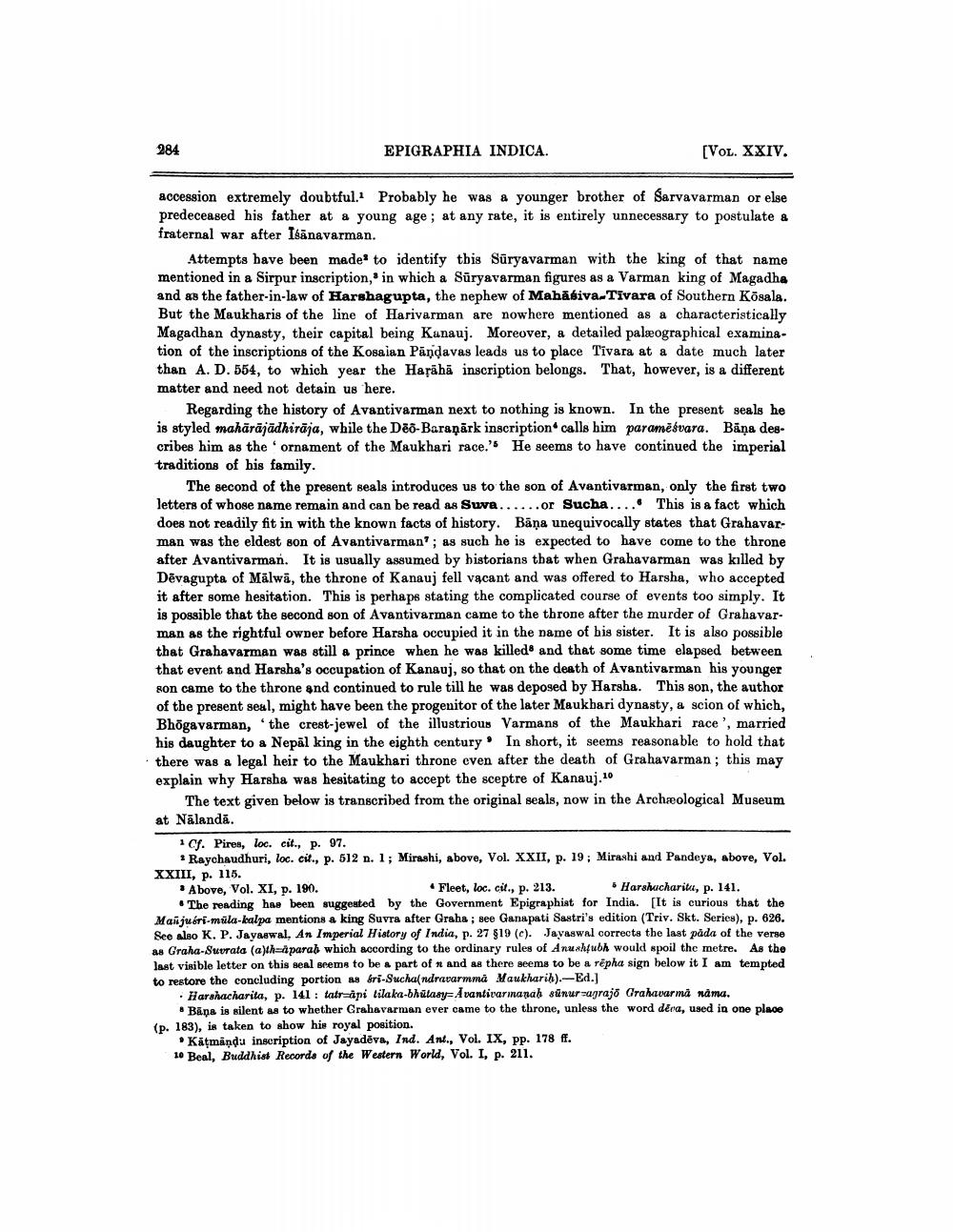________________
284
EPIGRAPHIA INDICA.
[VOL. XXIV.
accession extremely doubtful. Probably he was a younger brother of Sarvavarman or else predeceased his father at a young age; at any rate, it is entirely unnecessary to postulate a fraternal war after Isänavarman.
Attempts bave been made to identify this Süryavarman with the king of that name mentioned in a Sirpur inscription, in which a Suryavarman figures as a Varman king of Magadha and as the father-in-law of Harshagupta, the nephew of Mahāśiva-Tīvara of Southern Kõsala. But the Maukharis of the line of Harivarman are nowhere mentioned as a characteristically Magadhan dynasty, their capital being Kunauj. Moreover, a detailed palæographical examination of the inscriptions of the Kosaian Pandavas leads us to place Tivara at a date much later than A. D. 554, to which year the Harāhā inscription belongs. That, however, is a different matter and need not detain us here.
Regarding the history of Avantivarman next to nothing is known. In the present seals he is styled mahārājādhirāja, while the D6-Baraņārk inscription calls him paramēsvara. Bāņa describes him as the ornament of the Maukhari race.' He seems to have continued the imperial traditions of bis family.
The second of the present seals introduces us to the son of Avantivarman, only the first two letters of whose name remain and can be read as Suva......or Sucha..... This is a fact which does not readily fit in with the known facts of history. Bāņa unequivocally states that Grahavarman was the eldest son of Avantivarman'; as such he is expected to have come to the throne after Avantivarman. It is usually assumed by historians that when Grahavarman was killed by Dévagupta of Mālwā, the throne of Kanauj fell vacant and was offered to Harsha, who accepted it after some hesitation. This is perhaps stating the complicated course of events too simply. It is possible that the second son of Avantivarman came to the throne after the murder of Grahavarman as the rightful owner before Harsha occupied it in the name of his sister. It is also possible that Grahavarman was still a prince when he was killed and that some time elapsed between that event and Harsha's occupation of Kanauj, so that on the death of Avantivarman his younger son came to the throne and continued to rule till he was deposed by Harsha. This son, the author of the present seul, might have been the progenitor of the later Maukhari dynasty, & scion of which, Bhögavarman, the crest-jewel of the illustrious Varmans of the Maukhari race', married his daughter to a Nepal king in the eighth century. In short, it seems reasonable to hold that there was a legal heir to the Maukhari throne even after the death of Grahavarman; this may explain why Harsha was hesitating to accept the sceptre of Kanauj.10
The text given below is transcribed from the original seals, now in the Archæological Museum at Nālandă.
1 Cf. Pires, loc. cit., p. 97.
Raychaudhuri, loc. cit., p. 512 n. 1; Mirashi, above, Vol. XXII, p. 19; Mirashi and Pandeya, above, Vol. XXIII, p. 115. * Above, Vol. XI, p. 190.
Fleet, loc. cit., p. 213.
Harshacharitu, p. 141. * The reading has been suggested by the Government Epigraphist for India. [It is curious that the Maijuári-müla-kalpa mentions a king Suvra after Graha; see Ganapati Sastri's edition (Triv. Skt. Series), p. 626. See also K. P. Jayaswal, An Imperial History of India, p. 27 519 (c). Jayaswal corrects the last pada of the verse as Graha-Suvrata (a)th=aparah which according to the ordinary rules of Anushtubh would spoil the metre. As the last visible letter on this seal seems to be a part of and as there seems to be a répha sign below it I am tempted to restore the concluding portion as bri-Suchandravarmma Maukharib).-Ed.]
Harshacharita, p. 141: tatrapi tilaka-bhulasy=Avantivarmanah sunur sagrajo Cirahavarma nama.
Bana is silent as to whether Grahavarman ever came to the throne, unless the word déra, used in one place (p. 183), is taken to show his royal position.
• Katmandu inscription of Jayadēva, Ind. Ant., Vol. IX, pp. 178 ff. 10 Beal, Buddhist Records of the Western World, Vol. I, p. 211.




